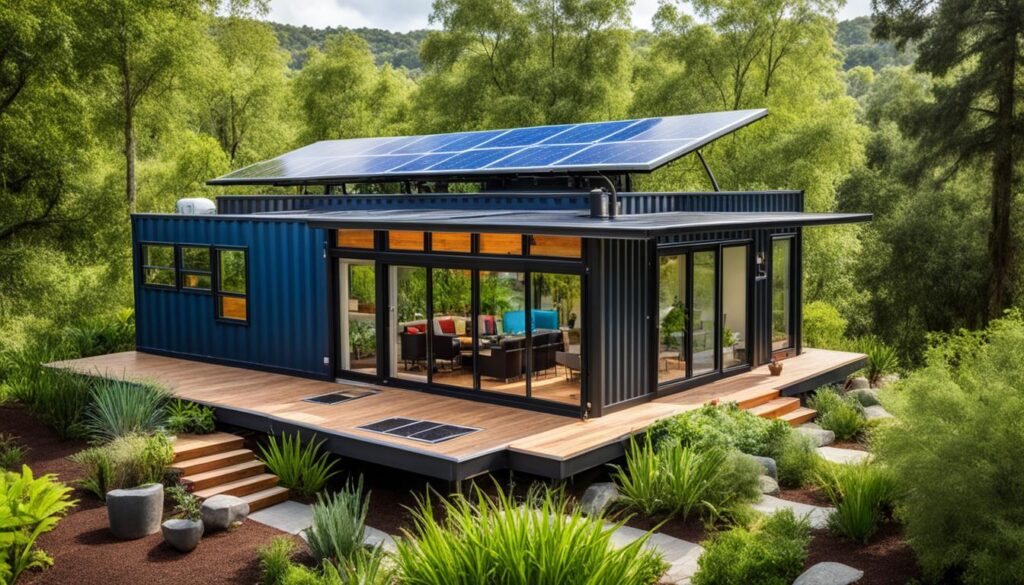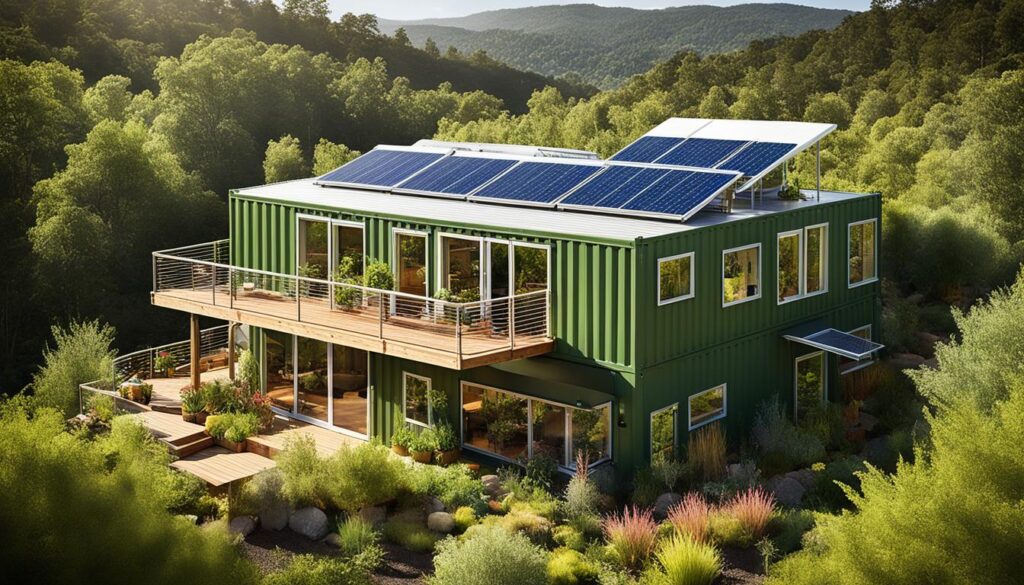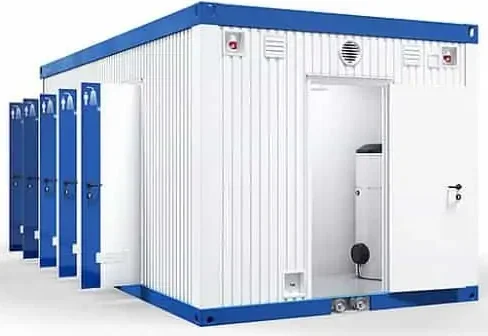In recent years, more people are looking into eco-friendly homes. Container homes are now popular for being green and affordable. They are made from recycled shipping containers. These homes are good for the planet and offer a new way to live.
Key Takeaways
- Container homes are a sustainable and eco-friendly housing solution made from recycled shipping containers.
- These innovative homes are designed to be affordable and have a lower environmental impact.
- Eco container homes provide practical, sustainable living options that help reduce the strain on natural resources.
- The growing popularity of container homes reflects a broader trend towards green architecture and off-grid living.
- These sustainable housing solutions offer an attractive alternative to traditional construction methods.
What Makes Container Homes an Eco-Friendly Choice?
Container homes are a green way to live that cuts down on harm to the planet. They use old shipping containers to make homes. This saves natural resources and cuts down on waste.
How Do Container Homes Help Preserve the Environment?
Container homes think about the planet. Using recycled shipping containers means we don’t need as much new stuff. This stuff often harms the earth a lot.
These homes also use renewable materials and save energy. Things like insulation and special windows help them be greener.
What Makes a Container Home Eco-friendly?
- Repurposed shipping containers reduce waste and the need for new materials
- Energy-efficient design, including insulation and passive solar features, cuts energy use
- Renewable energy sources, like solar panels, power these homes
- Compact and modular design uses space well, making a smaller footprint
- Strong build means they last longer, so we don’t replace them as much
Container homes are great for the planet and offer a cool way to live. They show us how to live better and be kind to the earth. These green architecture ideas are leading us to a better future.

“Sustainability is no longer about doing less harm, it’s about doing more good.” – Jochen Zeitz
Exploring the Durability of Eco-Container Homes
Eco-container homes are a great choice for those looking for sustainable living. They use big metal shipping containers. These homes are not only good for the planet but also last a long time. With the right care, they can be a home for many years.
How Many Years Can an Eco-Container Home Last?
Eco-container homes are very strong because they’re made from shipping containers. They can last 10 to 20 years or more with good care. The use of durable construction materials and eco-friendly materials helps them last longer. This makes them a smart choice for sustainable housing.
Also, container homes are easy to fix and replace parts if needed. This makes them last even longer. The metal containers are very long-lasting and durable. This makes them a strong and sustainable choice for container home lifespan.
“Eco-container homes are not only environmentally friendly but also built to last, providing homeowners with a sturdy and long-lasting living solution.”
Choosing an eco-container home means your money is well spent. These homes are made to last through time and weather. They offer a long-lasting and eco-friendly place to live for many years.

Environmental Benefits of Shipping Container Homes
Shipping container homes are getting popular for many reasons. They are affordable and efficient to build. They also offer big environmental benefits. These homes are a green choice for those looking for sustainable living.
One big plus of shipping container homes is they can be recycled. Containers are made to last a long time. When turned into homes, they cut down on waste. This is good for the planet and supports sustainable building.
These homes are also more energy-efficient. They stay warm or cool better because of special insulation. This means they use less energy, which lowers bills and is better for the environment.
Another good thing about shipping container homes is they use local materials. This means less travel for the materials. It makes these homes even greener.
| Environmental Benefit | Explanation |
|---|---|
| Recyclability | Shipping containers are inherently durable and long-lasting, reducing waste throughout the home’s lifecycle. |
| Energy Efficiency | Excellent insulation properties of shipping containers help reduce energy consumption for heating and cooling. |
| Local Sourcing | Using locally available shipping containers minimizes transportation-related emissions and carbon footprint. |
Choosing shipping container homes helps us live more sustainably. It’s good for the planet and offers many benefits for people and communities.
Powering Tiny Homes with Renewable Energy Sources
The tiny living movement is getting bigger. So, we need efficient and green power for these small homes. Luckily, tiny homes can use renewable energy. This cuts down on harm to the planet and lets people live off the grid.
How Can Tiny Homes Be Powered Using Renewable Energy Sources?
Photovoltaic (PV) solar panels are a top pick for tiny homes. They give clean energy and work well. You can put these panels on the roof or walls of a tiny home. They use the sun’s power for electricity.
Small wind turbines are another option. They turn wind into electricity. These turbines can be near or on the tiny home.
If a tiny home is near water, micro-hydropower is a good choice. It uses water flow to make electricity. With smart tech and efficient appliances, tiny homes can live off the grid. This means less harm to the environment.
| Renewable Energy Source | Advantages for Tiny Homes |
|---|---|
| Solar Photovoltaic (PV) Panels | Reliable, clean electricity generation; easy integration into tiny home design |
| Small Wind Turbines | Provide power in areas with consistent wind; can supplement solar energy |
| Micro-Hydropower Systems | Efficient electricity generation from running water; ideal for tiny homes near streams or rivers |
These renewable energy sources have many benefits for tiny homes. They are good for the planet, save money, and make homes more independent. As more people choose tiny living, using renewable energy will become key.
sustainable container housing solutions
Eco-tiny container homes are a great choice for those looking for a green and stylish home. They use old shipping containers. This makes them look cool and helps save materials.
Inside, you’ll find everything you need for a cozy home. Sometimes, several containers are linked together. This lets the homes grow with your family or needs.
How Are Eco-tiny Container Homes Made?
Making eco-tiny container homes takes a few steps:
- First, builders pick out used shipping containers. They choose ones that are still in good shape. This way, they keep them out of the landfill.
- Then, they change the containers for tiny homes. They add windows, insulation, and plumbing. They also put in electrical systems.
- Next, they use green materials. This includes bamboo flooring, solar panels, and energy-saving appliances.
- Finally, they set up the layout. You can have a single unit or many connected ones. This lets you design your space just how you like.
Eco-tiny container homes are strong and versatile. They’re a smart choice for anyone wanting a small, green home. The design is modern, and they’re made with materials that are good for the planet.
| Feature | Benefit |
|---|---|
| Repurposed shipping containers | Reduces waste and conserves resources |
| Modular construction | Allows for customization and flexibility |
| Incorporation of renewable materials | Enhances the home’s sustainability |
Container Home Builders in Las Vegas
Las Vegas is now a top spot for eco-friendly homes made from containers. Local companies are making homes that are both green and stylish. They mix sustainable living with the city’s lively vibe.
Who Builds Container Homes in Las Vegas?
Alternative Living Spaces is a top name in Las Vegas for container homes. They make modern homes from containers that use land well. These homes are perfect for living or working. Their team uses the latest building methods for strong, long-lasting homes.
Modular Homes of Las Vegas is another big name. They offer many kinds of custom container homes. These homes fit the needs and likes of Las Vegas people. They aim to make living green and different.
“We are dedicated to transforming the way people live in Las Vegas by providing eco-friendly and versatile container home options that not only enhance the local landscape but also promote a greener, more sustainable future.”
Las Vegas also has many small, special container home builders. They each bring new ideas to modular construction and custom container homes. These companies are changing the way we think about alternative housing in Las Vegas.
Selecting the Right Container Home Builder
Finding the right builder for your container home is very important. You want a home that is good for the planet, fits your budget, and looks just how you want it. Look for a builder who has lots of experience and a good name.
They should talk well with you and work together to make your dream home. This way, you can make sure your home is eco-friendly and looks exactly how you want it.
Choose a builder who knows a lot about making container homes. They should have examples of their work and be able to give you names of people who are happy with their homes. This shows they can make a strong, green home that fits your needs.
When you pick the right builder, you start your journey to a sustainable life. Your new home will show off your style and prove you care about the planet and saving money.
“Choosing the right container home builder is the key to unlocking your dream of sustainable, custom-designed living.”
Atlanta’s Innovative Approach to Container Housing
Atlanta is leading the way in solving homelessness and making homes affordable. They’re using shipping containers to build homes fast and in a green way. This helps people in need quickly.
Atlanta Housing is behind this bold move. They want to fix the housing crisis and encourage creativity in city planning. By helping pay for these homes, Atlanta is making sure more people can live affordably. This helps make the community stronger and more welcoming.
Atlanta’s plan is about more than just homes. It shows a big commitment to making cities better for everyone. They focus on sustainable urban development and community-driven initiatives. This can be a model for other cities facing similar problems.
“Atlanta’s container housing program is a shining example of how local governments can leverage innovative approaches to address the pressing issues of affordable housing and homelessness solutions,” said a spokesperson for the city’s housing department.
Atlanta is making homes from shipping containers that are both cheap and good for the planet. This method fits with the city’s goals of being green and building a strong, united community.
Other cities are taking notice of Atlanta’s work. This program shows how community-driven initiatives can solve big social and environmental issues. By using shipping container housing, Atlanta is leading the way to a better, fairer future.
Potential Drawbacks of Shipping Container Homes
Shipping container homes are creative and affordable. But, they might not be the best choice for the long term. They have some limits that you should think about before deciding.
One big issue is the insulation challenges. Containers are made of metal, which is great for structure but bad for walls. It lets heat and cold pass through easily. To stay warm or cool, you need good insulation. But, this takes up space, making the home feel small.
Another problem is thermal bridging. This happens when containers are stacked. The metal can move heat from outside to inside. This makes insulation less effective and uses more energy for heating and cooling.
Also, the sustainability of the materials is a worry. Making and getting metal uses a lot of energy and pollutes more than some other materials. This might cancel out the good things about using shipping containers again.
Lastly, toxic hazards can be in older containers. They might have paint with lead. This is bad for people living there and needs to be fixed before it’s safe.
To fix these issues, builders of container homes should focus on insulation, thermal management, material sustainability, and toxic hazard mitigation. This way, they can make homes that are good for the planet and last a long time.
Conclusion
Shipping container homes are a new and cheap way to live sustainably. They are great for those who want to live in a way that’s good for the planet. But, it’s important to think about the good and bad before choosing this option.
Container homes can use renewable energy and be made to be green. But, they also have challenges like insulation and toxicity. We must fix these problems to make sure they last a long time.
We need more affordable and green homes. Using container homes wisely can help. By fixing their issues, we can make homes that are good for people and the planet.



